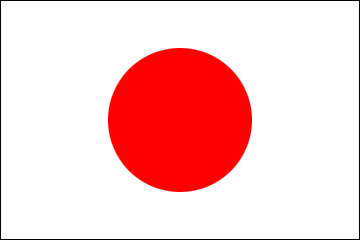FAQ about ALPS Treated Water
2023/8/28
On August 22nd, the Government of Japan has decided in the meeting to initiate the discharge of ALPS treated water into the sea and to request TEPCO to promptly prepare for the start of the discharge into the sea. If there are no interference due to weather or sea conditions, the day of the initiation of discharge into the sea is expected to be 24 August.
Following are some Q&A in this concern:
Q1.
Some media outlets are reporting that Japan will discharge “the treated nuclear contaminated water” or “dump radioactive water into the Pacific Ocean”. Will the government of Japan really decided to “dump” the “contaminated water”?
A1.
What is discharged into the ocean from TEPCO's Fukushima Daiichi Nuclear Power Plant is not “contaminated water” but “ALPS“ treated water (Advanced Liquid Processing System). ALPS is a pumping and filtration system, which uses a series of chemical reactions to remove 62 radionuclides from contaminated water. However, ALPS is not able to remove tritium from the contaminated water
(source: IAEA https://www.iaea.org/topics/response/fukushima-daiichi-nuclear-accident/fukushima-daiichi-alps-treated-water-discharge/faq)
Therefore, when ALPS treated water is discharged into the ocean, it is diluted significantly by more than 100 times with seawater until the tritium concentration falls below 1/40th of the regulatory standard. This dilution further dilutes radioactive materials other than tritium from the regulatory standard value.
The water to be discharged into the ocean does not contain radioactive materials exceeding the regulatory limits, and is neither "the treated nuclear contaminated water" nor "radioactive water". These terms are not scientifically based. The IAEA has pointed out that in order to avoid public confusion, there must be a proper understanding of the terminology, and that there is a need to distinguish these terms. Also, the "water" discharged into the ocean is not “dumped”, but is a discharged in a “controlled manner”.
Q2. What is ALPS?
A2. Please refer to the following explanatory materials about ALPS.
Source: IAEA https://www.iaea.org/topics/response/fukushima-daiichi-nuclear-accident/fukushima-daiichi-alps-treated-water-discharge/faq
Q3. What is Tritium?
A3. Tritium is a relative of hydrogen that emits a low level of radiation. Tritium exists naturally and is found in rain water, sea water, tap water and inside the human body as a form of tritiated water.
Tritium is taken into the human body via drinking water and is excreted from the body, and then circulates in nature as the water does. It has not been confirmed to be accumulated in humans or specific organisms.
For more information, please watch the two explanatory videos below:
https://www.tepco.co.jp/en/decommission/progress/watertreatment/tritium/index-e.html#about
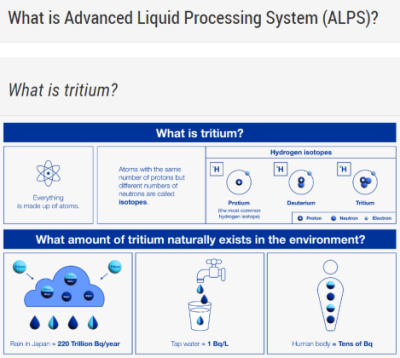
Source: IAEA https://www.iaea.org/topics/response/fukushima-daiichi-nuclear-accident/fukushima-daiichi-alps-treated-water-discharge/faq
Q4. Even though the concentration of tritium in the water to be discharged is well below the regulatory standard, if a large amount of "ALPS treated water" is to be discharged, will it not have a negative impact on the environment?
A4. The annual release of ALPS treated water from TEPCO's Fukushima Daiichi Nuclear Power Plant to the ocean is to be below the pre-accident control target of 22 trillion Bq. While other countries also discharge tritium into the sea in compliance with their own domestic laws and regulations, the amount of tritium in the ALPS treated water is smaller than the amount of tritium discharged from many nuclear power plants and other facilities in other countries.
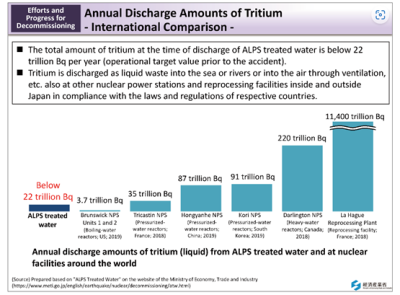
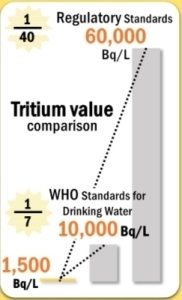
Source: Ministry of Environment, Japan https://www.env.go.jp/en/chemi/rhm/basic-info/1st/06-03-09.html
[Reference: Measuring Radiation]
Source: video by IAEA Measuring Radiation | IAEA
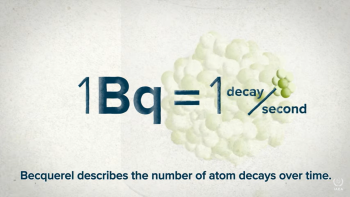
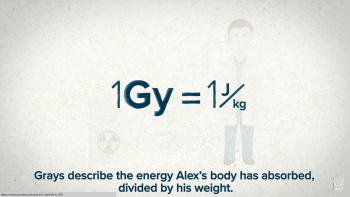
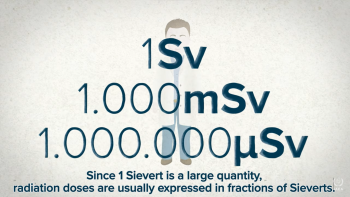
Q5. Will ALPS treated water be discharged in a safe method?
A5. TEPCO will measure all water before dilution and ensures that water to be discharged into the sea meets regulatory standards before discharge.
The IAEA Task Force, comprised of experts from the IAEA Secretariat and 11 international experts, will conduct corroboration of monitoring by TEPCO. The IAEA Task Force is comprised of internationally recognized experts from 11 countries including our neighboring countries appointed by the IAEA; Argentina, Australia, Canada, China, France, Marshall Islands, Republic of Korea, Russian Federation, United Kingdom, United States, and Vietnam.
Q6. Did Japan not consider any disposal method other than ocean discharge? / Why did Japan not request the IAEA to assess disposal options other than oceanic release?
A6. Japanese experts have had comprehensive discussions on this matter for more than six years in the Tritium Water Task Force and the Subcommittee on the Handling of ALPS treated Water (the "ALPS Subcommittee") which include evaluation of five disposal methods (geologic injection, ocean release, vapor release, hydrogen release, and underground burial).
In February 2020, the ALPS Subcommittee Report was issued. The report concluded that the discharge into the sea "can be more reliably implemented because it is commonly practiced in nuclear power plant around the world, the safety of the discharge facilities has been demonstrated, and the discharge into the sea can be most accurately monitored."
The ALPS Subcommittee's report was reviewed by the IAEA in April of the same year, which noted that "the recommendations made by the ALPS Subcommittee were based on a sufficiently comprehensive analysis and on a sound scientific and technical basis" and that the discharge into the sea is "technically feasible”.
Q7. If ALPS-treated water is safe, why not use it in Japan for drinking water, agricultural use, etc.?
A7. Although ALPS treated water meets the regulatory standards for radioactive materials, it is not suitable for general drinking water or agricultural use because it is diluted with a large amount of seawater. Although desalination technology exists, seawater is not used for drinking or agricultural purposes in other countries and regions.
On the other hand, if ALPS treated water were used for agricultural purposes, there is no relevant experience either in Japan or internationally in terms of monitoring the effects of using treated water for agricultural purpose, and no monitoring methods have been established. This is an obstacle to the option of discharge into soil.
IAEA noted that the recommendations of the ALPS Subcommittee on the discharge of ALPS treated water to the sea “were based on a sufficiently comprehensive analysis and on a sound scientific and technical basis" and that the discharge into the sea is "technically feasible”.
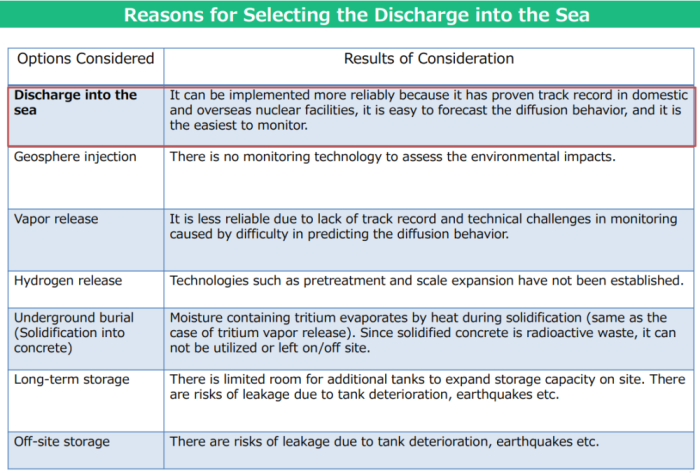
Following are some Q&A in this concern:
Q1.
Some media outlets are reporting that Japan will discharge “the treated nuclear contaminated water” or “dump radioactive water into the Pacific Ocean”. Will the government of Japan really decided to “dump” the “contaminated water”?
A1.
What is discharged into the ocean from TEPCO's Fukushima Daiichi Nuclear Power Plant is not “contaminated water” but “ALPS“ treated water (Advanced Liquid Processing System). ALPS is a pumping and filtration system, which uses a series of chemical reactions to remove 62 radionuclides from contaminated water. However, ALPS is not able to remove tritium from the contaminated water
(source: IAEA https://www.iaea.org/topics/response/fukushima-daiichi-nuclear-accident/fukushima-daiichi-alps-treated-water-discharge/faq)
Therefore, when ALPS treated water is discharged into the ocean, it is diluted significantly by more than 100 times with seawater until the tritium concentration falls below 1/40th of the regulatory standard. This dilution further dilutes radioactive materials other than tritium from the regulatory standard value.
The water to be discharged into the ocean does not contain radioactive materials exceeding the regulatory limits, and is neither "the treated nuclear contaminated water" nor "radioactive water". These terms are not scientifically based. The IAEA has pointed out that in order to avoid public confusion, there must be a proper understanding of the terminology, and that there is a need to distinguish these terms. Also, the "water" discharged into the ocean is not “dumped”, but is a discharged in a “controlled manner”.
Q2. What is ALPS?
A2. Please refer to the following explanatory materials about ALPS.
- Explanatory movie by TEPCO (https://www4.tepco.co.jp/en/news/library/archive-e.html?video_uuid=gd90o6m8&catid=69631)
- Schematic diagram by IAEA

Source: IAEA https://www.iaea.org/topics/response/fukushima-daiichi-nuclear-accident/fukushima-daiichi-alps-treated-water-discharge/faq
Q3. What is Tritium?
A3. Tritium is a relative of hydrogen that emits a low level of radiation. Tritium exists naturally and is found in rain water, sea water, tap water and inside the human body as a form of tritiated water.
Tritium is taken into the human body via drinking water and is excreted from the body, and then circulates in nature as the water does. It has not been confirmed to be accumulated in humans or specific organisms.
For more information, please watch the two explanatory videos below:
https://www.tepco.co.jp/en/decommission/progress/watertreatment/tritium/index-e.html#about

Source: IAEA https://www.iaea.org/topics/response/fukushima-daiichi-nuclear-accident/fukushima-daiichi-alps-treated-water-discharge/faq
Q4. Even though the concentration of tritium in the water to be discharged is well below the regulatory standard, if a large amount of "ALPS treated water" is to be discharged, will it not have a negative impact on the environment?
A4. The annual release of ALPS treated water from TEPCO's Fukushima Daiichi Nuclear Power Plant to the ocean is to be below the pre-accident control target of 22 trillion Bq. While other countries also discharge tritium into the sea in compliance with their own domestic laws and regulations, the amount of tritium in the ALPS treated water is smaller than the amount of tritium discharged from many nuclear power plants and other facilities in other countries.


Source: Ministry of Environment, Japan https://www.env.go.jp/en/chemi/rhm/basic-info/1st/06-03-09.html
[Reference: Measuring Radiation]
Source: video by IAEA Measuring Radiation | IAEA



Q5. Will ALPS treated water be discharged in a safe method?
A5. TEPCO will measure all water before dilution and ensures that water to be discharged into the sea meets regulatory standards before discharge.
The IAEA Task Force, comprised of experts from the IAEA Secretariat and 11 international experts, will conduct corroboration of monitoring by TEPCO. The IAEA Task Force is comprised of internationally recognized experts from 11 countries including our neighboring countries appointed by the IAEA; Argentina, Australia, Canada, China, France, Marshall Islands, Republic of Korea, Russian Federation, United Kingdom, United States, and Vietnam.
Q6. Did Japan not consider any disposal method other than ocean discharge? / Why did Japan not request the IAEA to assess disposal options other than oceanic release?
A6. Japanese experts have had comprehensive discussions on this matter for more than six years in the Tritium Water Task Force and the Subcommittee on the Handling of ALPS treated Water (the "ALPS Subcommittee") which include evaluation of five disposal methods (geologic injection, ocean release, vapor release, hydrogen release, and underground burial).
In February 2020, the ALPS Subcommittee Report was issued. The report concluded that the discharge into the sea "can be more reliably implemented because it is commonly practiced in nuclear power plant around the world, the safety of the discharge facilities has been demonstrated, and the discharge into the sea can be most accurately monitored."
The ALPS Subcommittee's report was reviewed by the IAEA in April of the same year, which noted that "the recommendations made by the ALPS Subcommittee were based on a sufficiently comprehensive analysis and on a sound scientific and technical basis" and that the discharge into the sea is "technically feasible”.
Q7. If ALPS-treated water is safe, why not use it in Japan for drinking water, agricultural use, etc.?
A7. Although ALPS treated water meets the regulatory standards for radioactive materials, it is not suitable for general drinking water or agricultural use because it is diluted with a large amount of seawater. Although desalination technology exists, seawater is not used for drinking or agricultural purposes in other countries and regions.
On the other hand, if ALPS treated water were used for agricultural purposes, there is no relevant experience either in Japan or internationally in terms of monitoring the effects of using treated water for agricultural purpose, and no monitoring methods have been established. This is an obstacle to the option of discharge into soil.
IAEA noted that the recommendations of the ALPS Subcommittee on the discharge of ALPS treated water to the sea “were based on a sufficiently comprehensive analysis and on a sound scientific and technical basis" and that the discharge into the sea is "technically feasible”.

